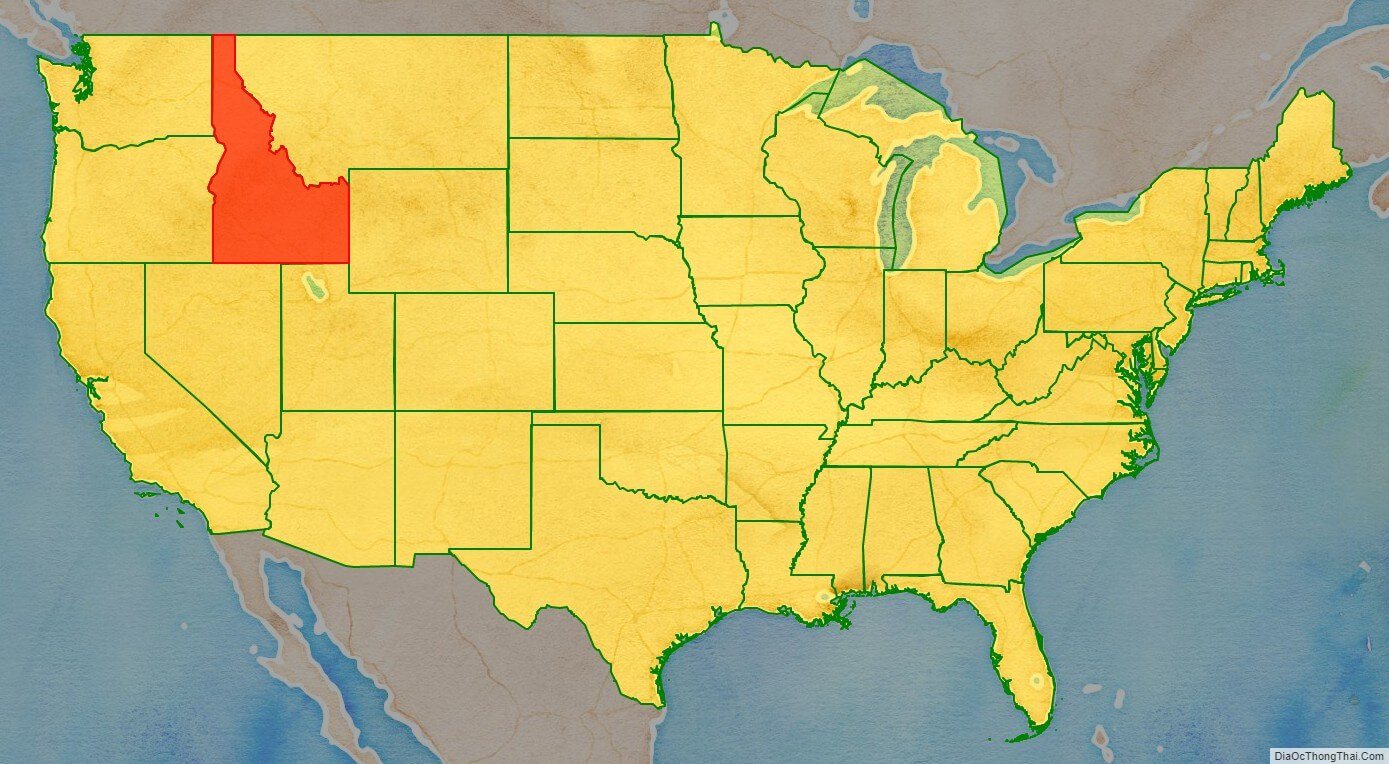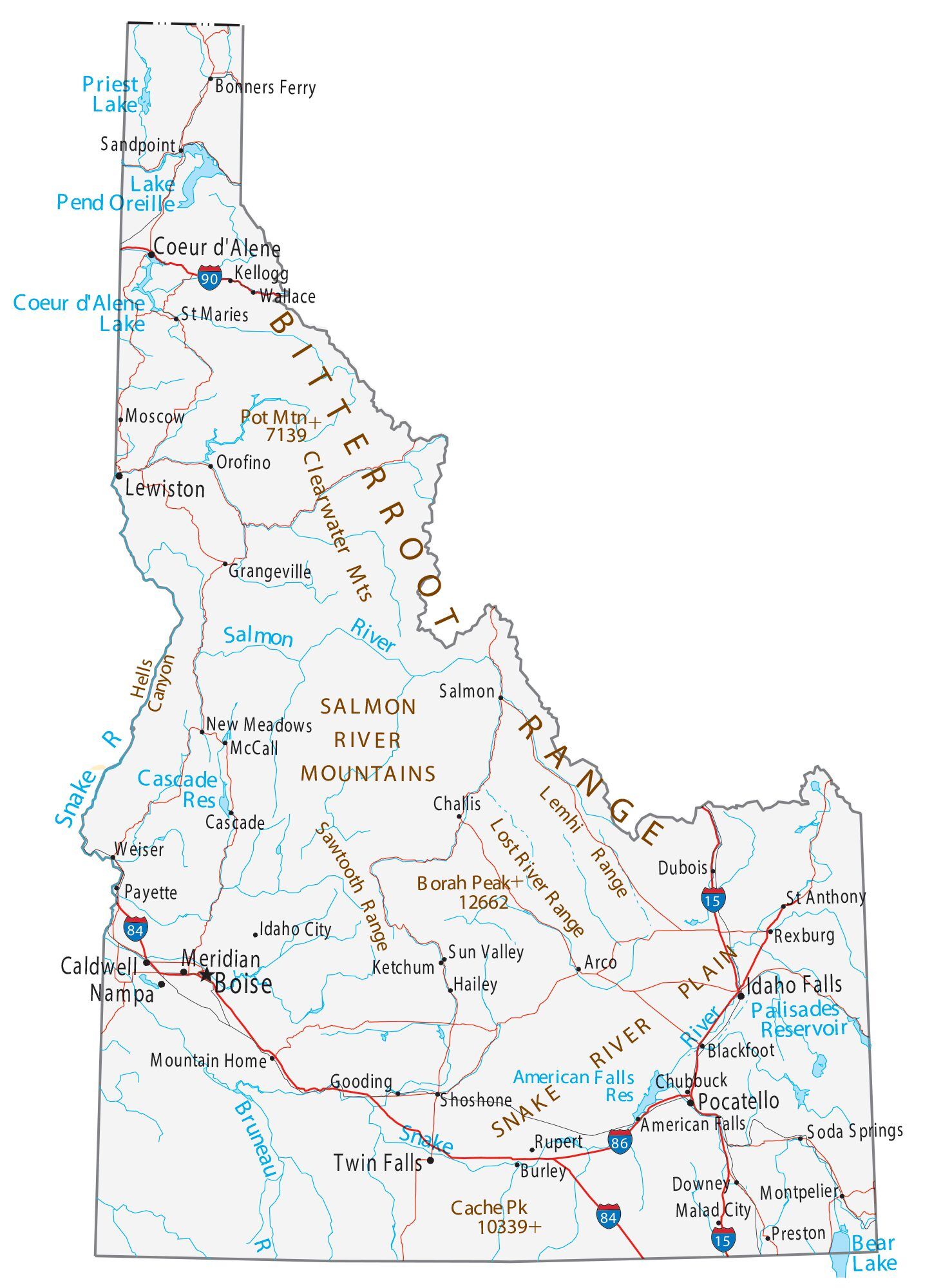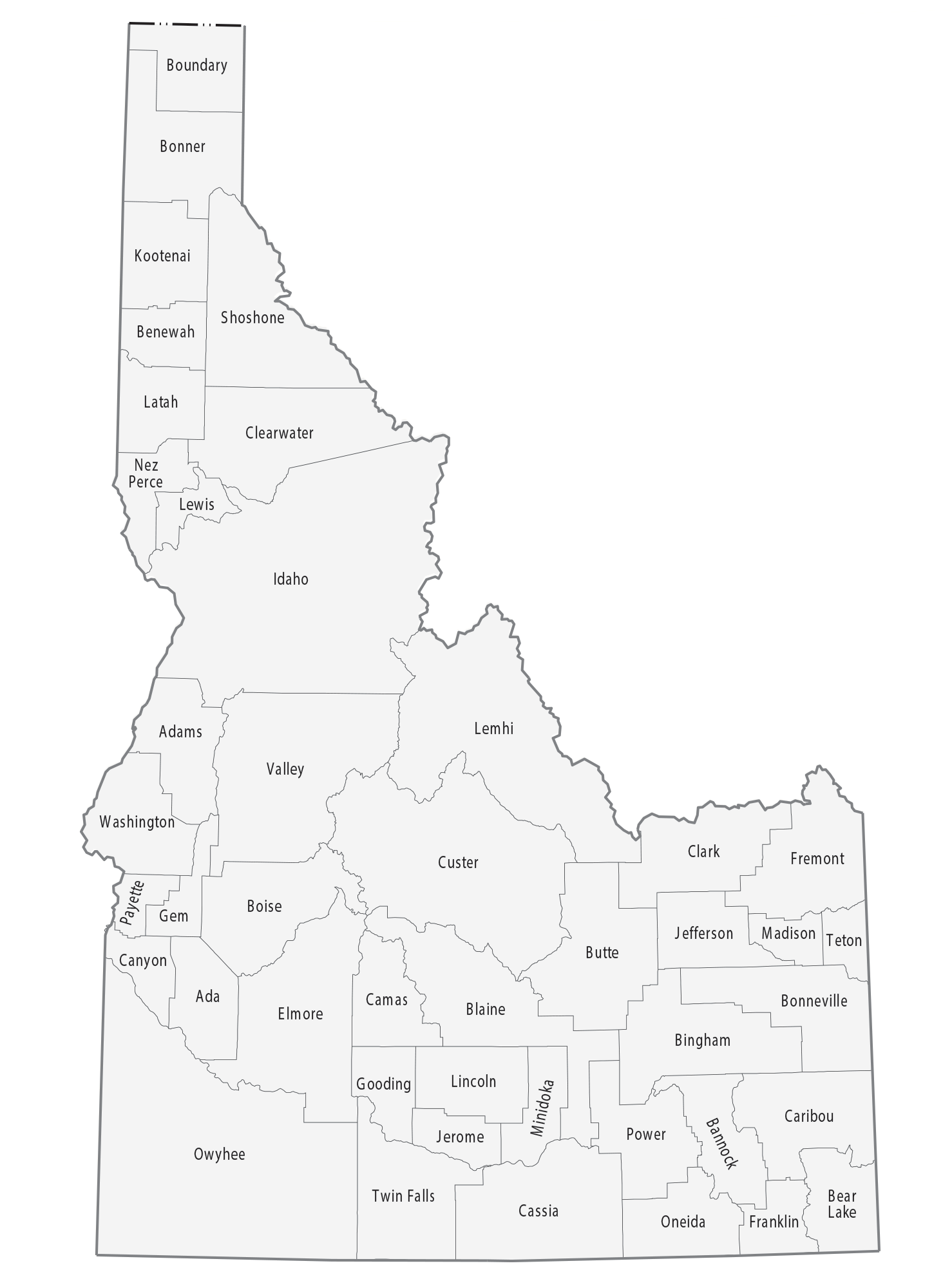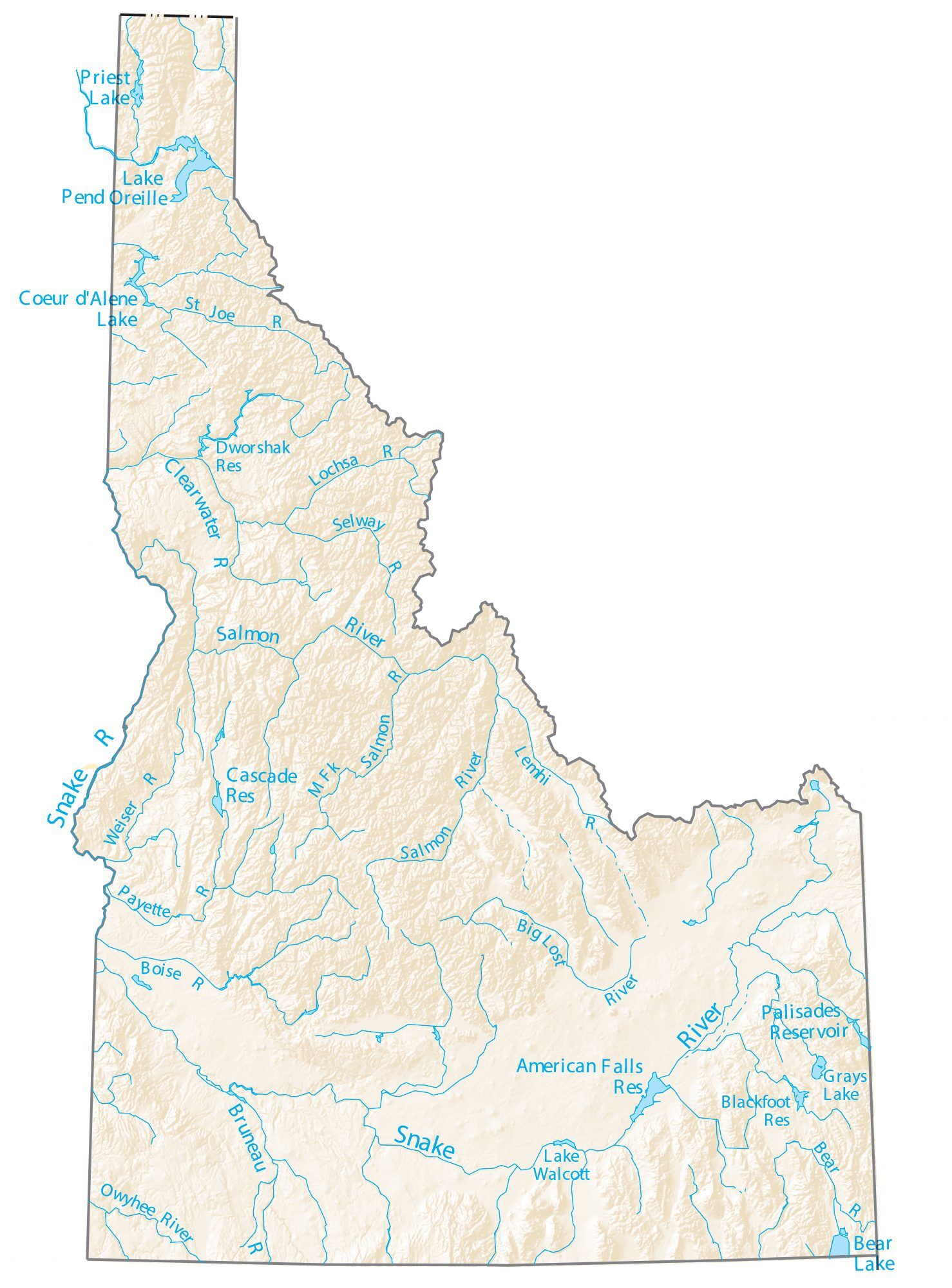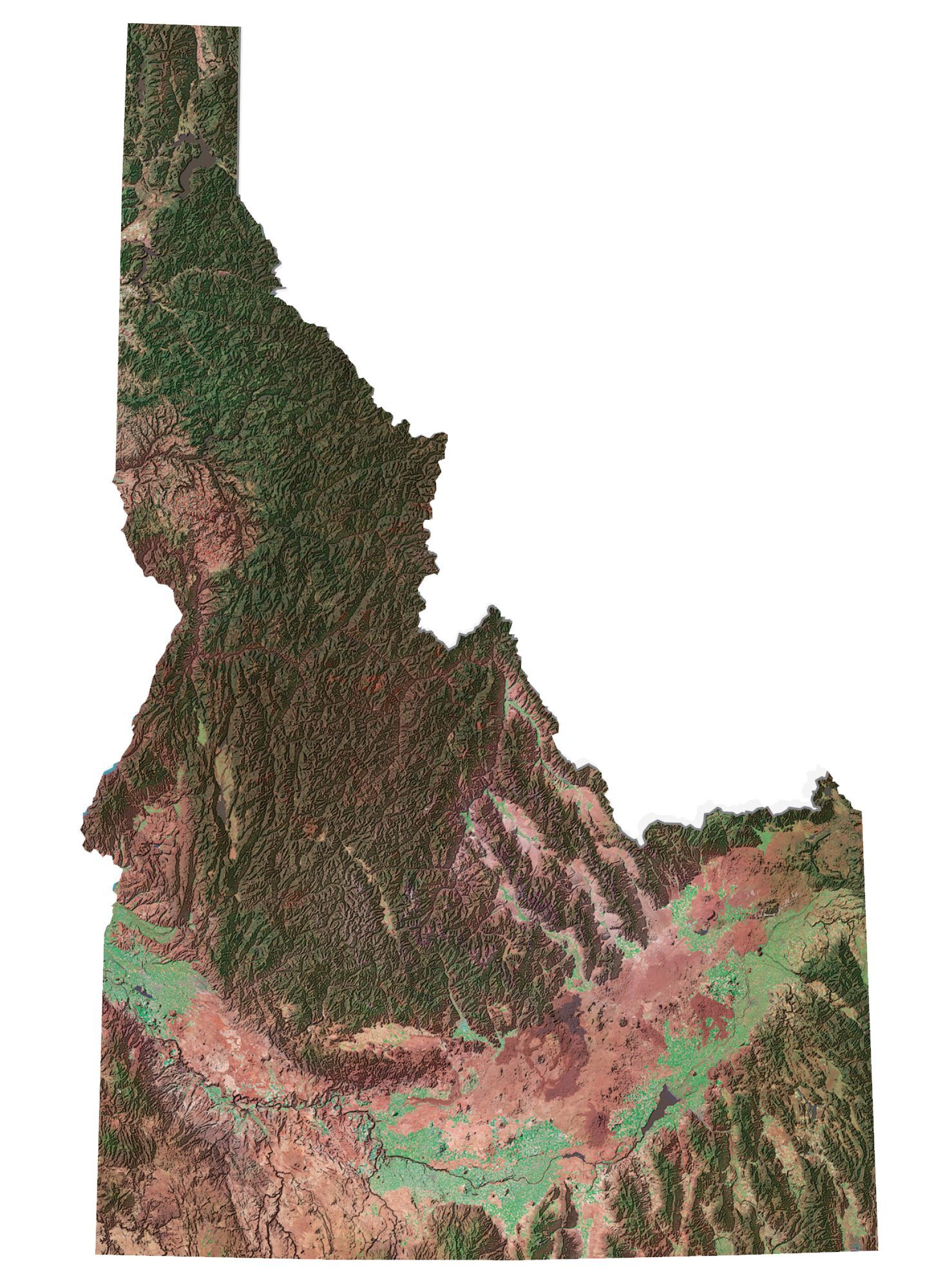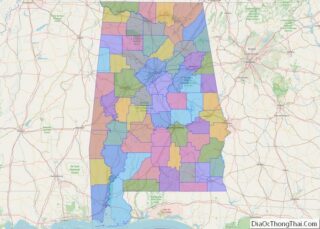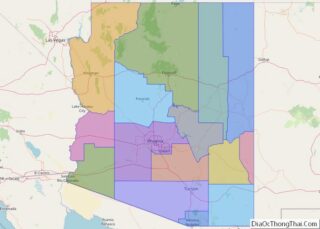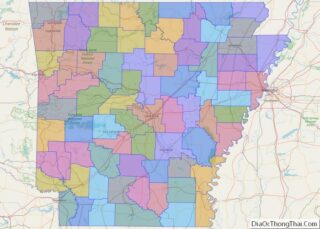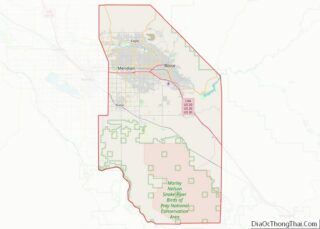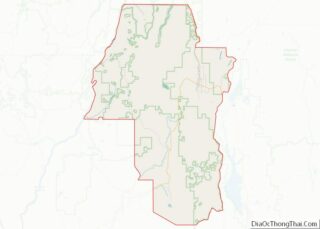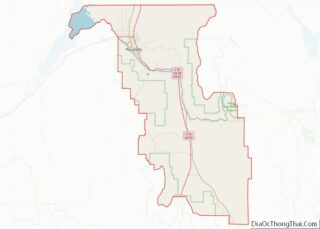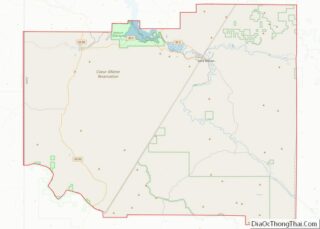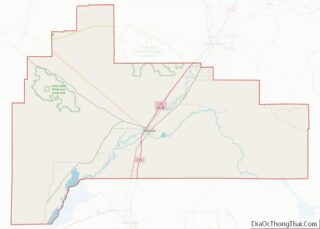Idaho (/ˈaɪdəhoʊ/ (listen) EYE-də-hoh) is a state in the Pacific Northwest region of the Western United States. To the north, it shares a small portion of the Canada–United States border with the province of British Columbia. It borders the states of Montana and Wyoming to the east, Nevada and Utah to the south, and Washington and Oregon to the west. The state’s capital and largest city is Boise. With an area of 83,570 square miles (216,400 km), Idaho is the 14th largest state by land area, but with a population of approximately 1.8 million, it ranks as the 13th least populous and the 7th least densely populated of the 50 U.S. states.
For thousands of years, and prior to European colonization, Idaho has been inhabited by native peoples. In the early 19th century, Idaho was considered part of the Oregon Country, an area of dispute between the U.S. and the British Empire. It officially became a U.S. territory with the signing of the Oregon Treaty of 1846, but a separate Idaho Territory was not organized until 1863, instead being included for periods in Oregon Territory and Washington Territory. Idaho was eventually admitted to the Union on July 3, 1890, becoming the 43rd state.
Forming part of the Pacific Northwest (and the associated Cascadia bioregion), Idaho is divided into several distinct geographic and climatic regions. The state’s north, the relatively isolated Idaho Panhandle, is closely linked with Eastern Washington, with which it shares the Pacific Time Zone—the rest of the state uses the Mountain Time Zone. The state’s south includes the Snake River Plain (which has most of the population and agricultural land), and the southeast incorporates part of the Great Basin. Idaho is quite mountainous, and contains several stretches of the Rocky Mountains. The United States Forest Service holds about 38% of Idaho’s land, the highest proportion of any state.
Industries significant for the state economy include manufacturing, agriculture, mining, forestry, and tourism. A number of science and technology firms are either headquartered in Idaho or have factories there, and the state also contains the Idaho National Laboratory, which is the country’s largest Department of Energy facility. Idaho’s agricultural sector supplies many products, but the state is best known for its potato crop, which comprises around one-third of the nationwide yield. The official state nickname is the “Gem State”, a figurative expression which references Idaho’s natural beauty.
| Before statehood: | Oregon Territory, Washington Territory, Idaho Territory |
|---|---|
| Admitted to the Union: | July 3, 1890 (43rd) |
| Capital: | Boise |
| Capital – largest city: | largest city |
| Largest metro and urban areas: | Boise |
| Elevation: | 5,000 ft (1,520 m) |
| Total Area: | 83,569 sq mi (216,443 km) |
| Area Rank: | 15th |
| Total Population: | 1,839,106 |
| Population Rank: | 38th |
| Population Density: | 21.6/sq mi (8.33/km) |
| Population Density Rank: | 44th |
| Median Household Income: | $76,918 |
| Income Rank: | 31st |
| Demonym(s): | Idahoan |
| USPS abbreviation: | ID |
| ISO 3166 code: | US-ID |
| Website: | www.idaho.gov |
Online Interactive Map
Click on ![]() to view map in "full screen" mode.
to view map in "full screen" mode.
Idaho location map. Where is Idaho state?
Idaho Road Map
Idaho Map – Roads & Cities
Idaho Street Map
History
Humans may have been present in the Idaho area as long as 14,500 years ago. Excavations at Wilson Butte Cave near Twin Falls in 1959 revealed evidence of human activity, including arrowheads, that rank among the oldest dated artifacts in North America. American Indian peoples predominant in the area included the Nez Percé in the north and the Northern and Western Shoshone in the south.
A Late Upper Paleolithic site was identified at Cooper’s Ferry in western Idaho near the town of Cottonwood by archaeologists in 2019. Based on evidence found at the site, first people lived in this area 15,300 to 16,600 years ago, predating the Beringia land bridge by about a thousand years. The discoverers emphasized that they possess similarities with tools and artifacts discovered in Japan that date from 16,000 to 13,000 years ago. The discovery also showed that the first people might not have come to North America by land, as previously theorized. On the contrary, they probably came through the water, using a Pacific coastal route.
An early presence of French-Canadian trappers is visible in names and toponyms: Nez Percé, Cœur d’Alène, Boisé, Payette. Some of these names appeared prior to the Lewis and Clark and Astorian expeditions ,which included significant numbers of French and Métis guides recruited for their familiarity with the terrain.
Idaho, as part of the Oregon Country, was claimed by both the United States and Great Britain until the United States gained undisputed jurisdiction in 1846. From 1843 to 1849, present-day Idaho was under the de facto jurisdiction of the Provisional Government of Oregon. When Oregon became a state in 1849, what is now Idaho was situated in what remained of the original Oregon Territory, designated as the Washington Territory.
Between 1849 and the creation of the Idaho Territory in 1863, parts of present-day Idaho were included in the Oregon, Washington, and Dakota Territories. The new Idaho territory included present-day Idaho, Montana, and most of Wyoming. The Lewis and Clark expedition crossed Idaho in 1805 on the way to the Pacific, and in 1806, on the return trip, largely following the Clearwater River in both directions. The first non-indigenous settlement was Kullyspell House, established on the shore of Lake Pend Oreille in 1809 by David Thompson of the North West Company for fur trading. In 1812 Donald Mackenzie, working for the Pacific Fur Company at the time, established a post on the lower Clearwater River near present-day Lewiston. This post, known as “MacKenzie’s Post” or “Clearwater”, operated until the Pacific Fur Company was bought out by the North West Company in 1813, after which the post was abandoned. The first organized non-indigenous communities within the present borders of Idaho were established in 1860. The first permanent, substantial incorporated community was Lewiston, in 1861.
Idaho achieved statehood in 1890, following a difficult start as a territory, including the chaotic transfer of the territorial capital from Lewiston to Boise, disenfranchisement of Mormon polygamists upheld by the U.S. Supreme Court in 1890, and a federal attempt to split the territory between Washington Territory, which gained statehood in 1889, a year before Idaho, and the state of Nevada which had been a state since 1864, .
Idaho was one of the hardest hit of the Pacific Northwest states during the Great Depression. Prices plummeted for Idaho’s major crops: in 1932 a bushel of potatoes brought only ten cents compared to $1.51 in 1919, while Idaho farmers saw their annual income of $686 in 1929 drop to $250 by 1932.
In recent years, Idaho has expanded its commercial base as a tourism and agricultural state to include science and technology industries. Science and technology have become the largest single economic center (over 25% of the state’s total revenue) within the state and are greater than agriculture, forestry and mining combined.
During the COVID-19 pandemic, Idaho enacted statewide crisis standards of care as COVID-19 patients overwhelmed hospitals. The state had one of the lowest vaccination rates in the country as of mid-October 2021.
Idaho State Map – Places and Landmarks
Idaho Political Map
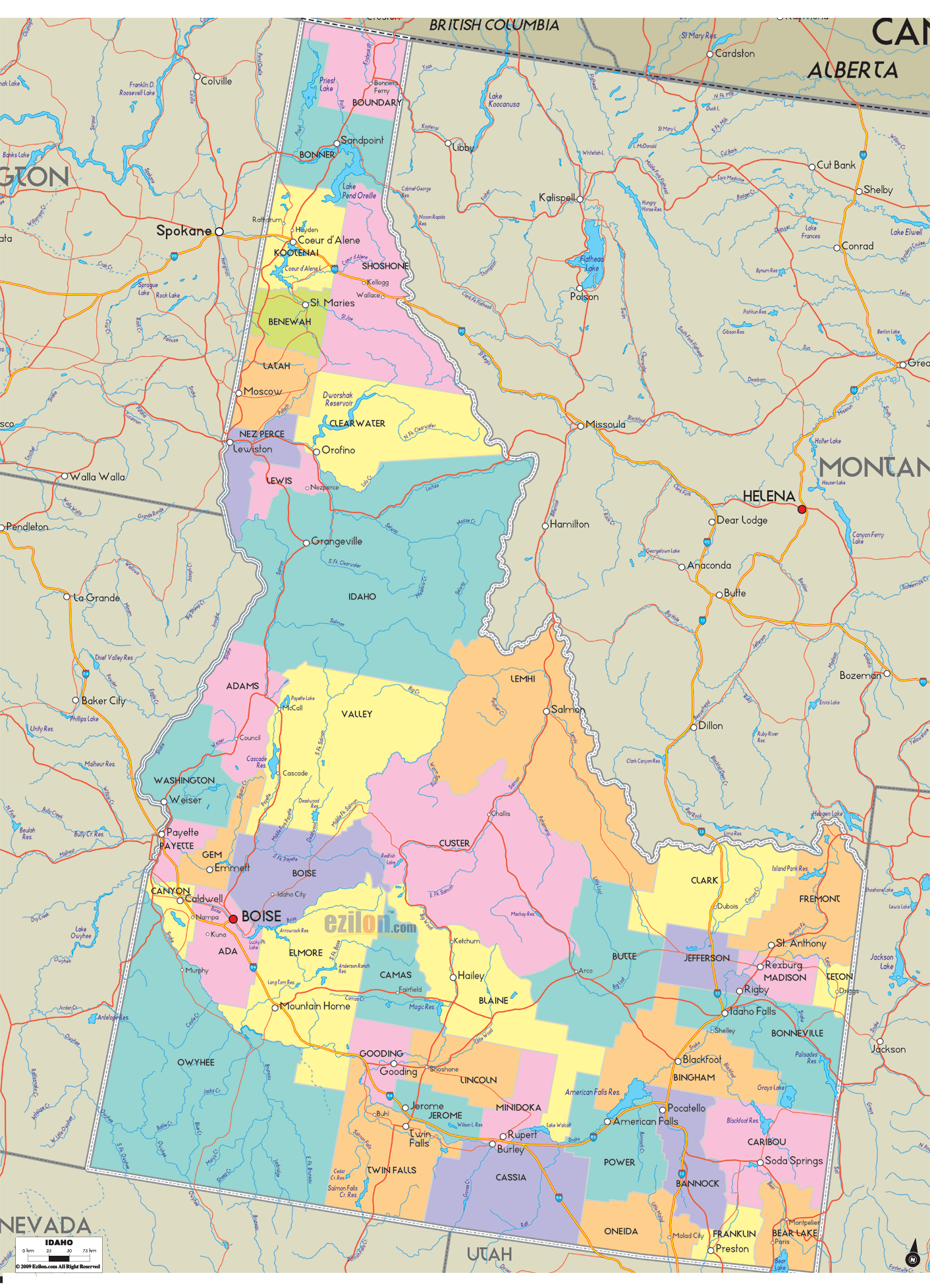
Idaho Lakes and Rivers Map
Geography
Idaho shares a border with six U.S. states and one Canadian province. The states of Washington and Oregon are to the west, Nevada and Utah are to the south, and Montana and Wyoming are to the east. Idaho also shares a short border with the Canadian province of British Columbia to the north.
The landscape is rugged, with some of the largest unspoiled natural areas in the United States. For example, at 2.3 million acres (930,000 ha), the Frank Church-River of No Return Wilderness Area is the largest contiguous area of protected wilderness in the continental United States. Idaho is a Rocky Mountain state with abundant natural resources and scenic areas. The state has snow-capped mountain ranges, rapids, vast lakes and steep canyons. The waters of the Snake River run through Hells Canyon, the deepest gorge in the United States. Shoshone Falls falls down cliffs from a height greater than Niagara Falls.
By far, the most important river in Idaho is the Snake River, a major tributary of the Columbia River. The Snake River flows from Yellowstone in northwestern Wyoming through the Snake River Plain in southern Idaho before turning north, leaving the state at Lewiston before joining the Columbia in Kennewick. Other major rivers are the Clark Fork/Pend Oreille River, the Spokane River, and, many major tributaries of the Snake River, including the Clearwater River, the Salmon River, the Boise River, and the Payette River. The Salmon River empties into the Snake in Hells Canyon and forms the southern boundary of Nez Perce County on its north shore, of which Lewiston is the county seat. The Port of Lewiston, at the confluence of the Clearwater and the Snake Rivers is the farthest inland seaport on the West Coast at 465 river miles from the Pacific at Astoria, Oregon.
The vast majority of Idaho’s population lives in the Snake River Plain, a valley running from across the entirety of southern Idaho from east to west. The valley contains the major cities of Boise, Meridian, Nampa, Caldwell, Twin Falls, Idaho Falls, and Pocatello. The plain served as an easy pass through the Rocky Mountains for westward-bound settlers on the Oregon Trail, and many settlers chose to settle the area rather than risking the treacherous route through the Blue Mountains and the Cascade Range to the west. The western region of the plain is known as the Treasure Valley, bound between the Owyhee Mountains to the southwest and the Boise Mountains to the northeast. The central region of the Snake River Plain is known as the Magic Valley.
Idaho’s highest point is Borah Peak, 12,662 ft (3,859 m), in the Lost River Range north of Mackay. Idaho’s lowest point, 710 ft (216 m), is in Lewiston, where the Clearwater River joins the Snake River and continues into Washington. The Sawtooth Range is often considered Idaho’s most famous mountain range. Other mountain ranges in Idaho include the Bitterroot Range, the White Cloud Mountains, the Lost River Range, the Clearwater Mountains, and the Salmon River Mountains.
Salmon-Challis National Forest is located in the east central sections of the state, with Salmon National Forest to the north and Challis National Forest to the south. The forest is in an area known as the Idaho Cobalt Belt, which consists of a 34 miles (55 km) long geological formation of sedimentary rock that contains some of the largest cobalt deposits in the U.S.
Idaho has two time zones, with the dividing line approximately midway between Canada and Nevada. Southern Idaho, including the Boise metropolitan area, Idaho Falls, Pocatello, and Twin Falls, are in the Mountain Time Zone. A legislative error (15 U.S.C. ch. 6 §264) theoretically placed this region in the Central Time Zone, but this was corrected with a 2007 amendment. Areas north of the Salmon River, including Coeur d’Alene, Moscow, Lewiston, and Sandpoint, are in the Pacific Time Zone, which contains less than a quarter of the state’s population and land area.
Climate
Idaho’s climate varies widely. Although the state’s western border is about 330 miles (530 km) from the Pacific Ocean, the maritime influence is still felt in Idaho; especially, in the winter when cloud cover, humidity, and precipitation are at their maximum extent. This influence has a moderating effect in the winter where temperatures are not as low as would otherwise be expected for a northern state with predominantly high elevations. In the panhandle, moist air masses from the coast are released as precipitation over the North Central Rockies forests, creating the North American inland temperate rainforest. The maritime influence is least prominent in the state’s eastern part where the precipitation patterns are often reversed, with wetter summers and drier winters, and seasonal temperature differences are more extreme, showing a more semi-arid continental climate.
Idaho can be hot, although extended periods over 98 °F (37 °C) are rare, except for the lowest point in elevation, Lewiston, which correspondingly sees little snow. Hot summer days are tempered by the low relative humidity and cooler evenings during summer months since, for most of the state, the highest diurnal difference in temperature is often in the summer. Winters can be cold, although extended periods of bitter cold weather below zero are unusual. Idaho’s all-time highest temperature of 118 °F (48 °C) was recorded at Orofino on July 28, 1934; the all-time lowest temperature of −60 °F (−51 °C) was recorded at Island Park Dam on January 18, 1943.
Lakes and rivers
- Clark Fork River
- Alturas Lake
- Bear River
- Bear Lake (Idaho–Utah)
- Boise River
- Clearwater River
- Hayden Lake
- Henry’s Lake
- Kootenai River
- Lake Cascade
- Lake Cleveland
- Lake Coeur d’Alene
- Lake Lowell
- Lake Walcott
- Pend Oreille – Largest in Idaho
- Little Redfish Lake
- Lucky Peak Lake
- Moyie River
- North Fork Clearwater River
- Pack River
- Payette Lake, (McCall)
- Pettit Lake
- Priest Lake
- Perkins Lake
- Portneuf River
- Redfish Lake
- Sawtooth Lake
- Snake River – Longest
- Stanley Lake
- St. Joe River
- Warm Lake
Protected areas
As of 2018:
- Salmon-Challis National Forest
- California National Historic Trail
- City of Rocks National Reserve
- Craters of the Moon National Monument and Preserve
- Hagerman Fossil Beds National Monument
- Lewis and Clark National Historic Trail
- Minidoka National Historic Site
- Nez Perce National Historical Park
- Oregon National Historic Trail
- Yellowstone National Park
- Pacific Northwest National Scenic Trail
- Hells Canyon National Recreation Area
- Sawtooth National Recreation Area
- Bear Lake National Wildlife Refuge
- Camas National Wildlife Refuge
- Deer Flat National Wildlife Refuge
- Frank Church—River of No Return Wilderness Area
- Grays Lake National Wildlife Refuge
- Kootenai National Wildlife Refuge
- Minidoka National Wildlife Refuge
- Snake River Birds of Prey National Conservation Area
- Bear Lake State Park
- Bruneau Dunes State Park
- Castle Rocks State Park
- City of Rocks National Reserve
- Coeur d’Alene Parkway State Park
- Dworshak State Park
- Eagle Island State Park
- Farragut State Park
- Harriman State Park
- Hells Gate State Park
- Henrys Lake State Park
- Heyburn State Park
- Lake Cascade State Park
- Lake Walcott State Park
- Land of the Yankee Fork State Park
- Lucky Peak State Park
- Massacre Rocks State Park
- McCroskey State Park
- Old Mission State Park
- Ponderosa State Park
- Priest Lake State Park
- Round Lake State Park
- Thousand Springs State Park
- Three Island Crossing State Park
- Trail of the Coeur d’Alenes
- Winchester Lake State Park
Idaho Physical Map
Idaho Topographic Map
Idaho Satellite Map
Others printable maps
Idaho Outline Map
Blank Idaho County Map
See also
Map of Idaho State and its subdivision:- Ada
- Adams
- Bannock
- Bear Lake
- Benewah
- Bingham
- Blaine
- Boise
- Bonner
- Bonneville
- Boundary
- Butte
- Camas
- Canyon
- Caribou
- Cassia
- Clark
- Clearwater
- Custer
- Elmore
- Franklin
- Fremont
- Gem
- Gooding
- Idaho
- Jefferson
- Jerome
- Kootenai
- Latah
- Lemhi
- Lewis
- Lincoln
- Madison
- Minidoka
- Nez Perce
- Oneida
- Owyhee
- Payette
- Power
- Shoshone
- Teton
- Twin Falls
- Valley
- Washington
- Alabama
- Alaska
- Arizona
- Arkansas
- California
- Colorado
- Connecticut
- Delaware
- District of Columbia
- Florida
- Georgia
- Hawaii
- Idaho
- Illinois
- Indiana
- Iowa
- Kansas
- Kentucky
- Louisiana
- Maine
- Maryland
- Massachusetts
- Michigan
- Minnesota
- Mississippi
- Missouri
- Montana
- Nebraska
- Nevada
- New Hampshire
- New Jersey
- New Mexico
- New York
- North Carolina
- North Dakota
- Ohio
- Oklahoma
- Oregon
- Pennsylvania
- Rhode Island
- South Carolina
- South Dakota
- Tennessee
- Texas
- Utah
- Vermont
- Virginia
- Washington
- West Virginia
- Wisconsin
- Wyoming
